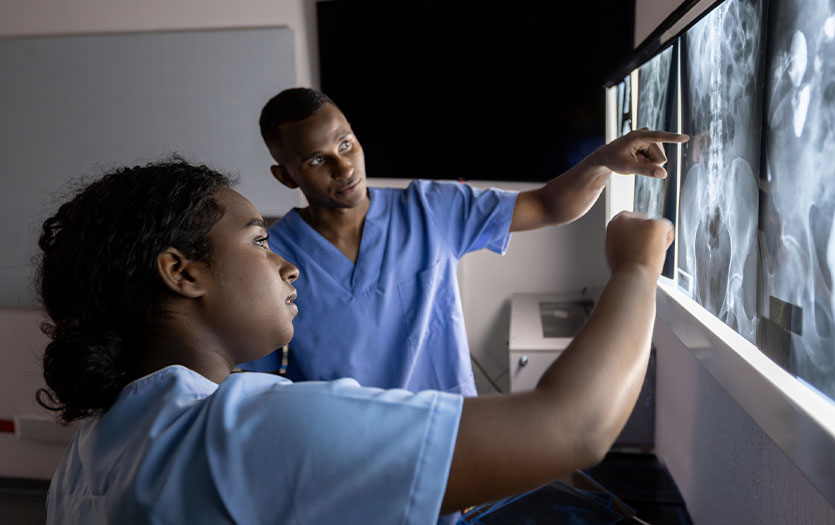
This post was written by Sarah Heck, Imaging Engagement Committee co-chair, Parkview Health.
In recognition of National Radiologic Technology Week®, we invite you to journey through the fascinating history of radiology as we highlight the pioneers whose work paved the way for today's advanced imaging practices.
How radiology came to be
The origins of radiology are anchored in the groundbreaking work of Wilhelm Conrad Roentgen, a German mechanical engineer and physicist. Through his experimentation, Roentgen uncovered a novel form of electromagnetic energy, which secured him the Nobel Prize in Physics in 1901 and forever changed the landscape of medical imaging.
On November 8, 1895, while investigating the behavior of electrons in near-total darkness, Roentgen observed a nearby workbench coated with barium platinocyanide emitting a faint green light. As he energized the electron tube, he recognized the connection between the flow of electrons and this new kind of ray.
Further tests demonstrated that when placed in the ray's path, objects of varying thickness displayed differences in transparency on a photographic plate. Roentgen tested this by momentarily placing his wife's hand in the ray's path, resulting in a striking and unique image.
The developed plate revealed the first X-ray image of a human, displaying the shadows of her hand bones and ring, with flesh casting a lighter shadow due to its permeability. He called this discovery "X-rays," with plans for a more precise title. However, it never materialized.
Several notable scientists have built on Roentgen's groundbreaking work. Thomas Edison developed fluoroscopy, which uses X-rays to create real-time moving images. However, the death of Edison's assistant, Clarence Dally, tragically brought to light the dangers of prolonged X-ray exposure and the need for a greater understanding of radiation safety.
In 1918, George Eastman introduced film to replace the impractical glass plates used for X-rays. This advancement led to the eventual shift from flammable cellulose nitrate sheets to stable polyester films.
Ultrasound technology
Ultrasound, or medical sonography, utilizes ultra-high-frequency sound waves for various medical applications.
In 1958, Ian Donald, a Scottish obstetrician and gynecologist, made a revolutionary breakthrough by applying ultrasound to monitor fetal development and identify abnormalities during pregnancy. His fascination with technology began when he witnessed its industrial application for detecting weld cracks. In July 1955, he evaluated the method on fibroids and ovarian cysts, even using a steak to demonstrate its ability to scan biological tissue effectively.
This work led to a compact ultrasound device tailored for expectant mothers. Today, ultrasound has evolved beyond obstetrics, precisely visualizing various organs, including the heart and blood vessels. The advancement of higher frequencies has significantly improved musculoskeletal imaging, providing orthopedic physicians with enhanced diagnostic capabilities.
Computed tomography
Developed in 1972 by Sir Godfrey Hounsfield and Allan Cormack, computed tomography, or CT scan, uses advanced technology similar to X-rays to create detailed cross-sectional images.
The CT scanner directs a narrow X-ray beam through the patient, capturing different angles to produce comprehensive data sets of human anatomy, often in 3-D.
The high-quality images obtained from CT scans are especially useful for diagnosing conditions overlooked by standard X-rays, such as:
-
Enlarged ventricles
-
Nerve and muscle abnormalities
-
Abdominal masses
In recognition of their contributions, Hounsfield and Cormack received the Nobel Prize in Physiology or Medicine in 1979.
Magnetic resonance imaging
Raymond Vahan Damadian, an American physician, is celebrated for developing the first magnetic resonance imaging (MRI) machine in 1969.
Unlike CT scanners, MRI technology does not use radiation. Instead, it produces detailed images of the body's cells and tissues by harnessing the atomic properties of magnetism and radio frequencies. This approach allows for an in-depth understanding of tissue health, delivering critical insights into the presence and condition of diseases at the cellular level.
In 1977, Damadian performed the first full-body MRI on a human to accurately diagnose cancer. This milestone demonstrated the capabilities of MR technology and set a new benchmark for diagnostic medicine.
Positron emission tomography (PET)
Positron Emission Tomography is a test that uses a special type of camera and a tracer to examine organs in the body. The tracer is a specialized substance administered intravenously (IV), like glucose, that accumulates in cells with high energy consumption, such as cancer cells. The tracer emits tiny positively charged particles called positrons, which the camera detects and converts into images on a computer.
The first PET camera designed for human studies was developed in 1973 by Edward Hoffman, Michael M. Ter-Pogossian and Michael E. Phelps at Washington University, with support from the Department of Energy and the National Institutes of Health. Phelps, often recognized as the inventor of PET, was awarded the Enrico Fermi Presidential Award in 1998 for his contributions. The inaugural whole-body PET scanner made its debut in 1977. Today, over 400 PET scanners are in operation worldwide.
Mammogram
In 1913, Albert Salomon, a German surgeon, began using X-rays to examine breast diseases, utilizing biopsied tissue due to the lack of existing equipment for breast imaging. His comparative studies on how diseased tissue spreads laid the foundation for subsequent research.
Beginning in the 1930s, several influential figures advanced the field of mammography, including:
-
Raoul Leborgne, a Uruguayan radiologist, discerned that breast tumors could proliferate without detection through palpation.
-
Charles Gros made significant enhancements to X-ray image quality in Strasbourg.
-
Jacob Gershon-Cohen and Helen Ingleby in Pennsylvania emphasized the role of mammography in the early detection of breast cancer.
In addition to these individual contributors, a landmark study conducted at Heidelberg University in 1957 led to increased clinical utilization of mammography. Heidelberg physicians worked with Siemens, an X-ray machine manufacturer, to develop a cone for focused X-ray delivery and breast compression. This advancement improved detail recognition while minimizing radiation exposure.
Learn more
To learn more about Parkview's Lab & Diagnostic Imaging services, visit our website here.



